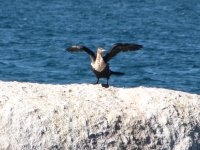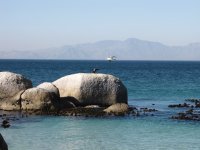-
Welcome to BirdForum, the internet's largest birding community with thousands of members from all over the world. The forums are dedicated to wild birds, birding, binoculars and equipment and all that goes with it.
Please register for an account to take part in the discussions in the forum, post your pictures in the gallery and more.
You are using an out of date browser. It may not display this or other websites correctly.
You should upgrade or use an alternative browser.
You should upgrade or use an alternative browser.
Boulder Beach, South Africa - historical (1 Viewer)
- Thread starter spocki
- Start date
More options
Who Replied?nartreb
Speak softly and carry a long lens
Those are not the birds that normally occupy one's attention at that beach 
A brownish head and neck and white belly are common in many species of cormorant, when the bird is immature. This bird has a black cap and black lower belly, so presumably it's molting into adult plumage. I can't tell what species it is.
The gull looks OK for kelp to me, though it looks OK for ring-billed too. Maybe somebody here can tell them apart (e.g. there should be a difference in the pattern of white spots on the wing-tips), but that's beyond my skill.
Edit: I didn't see the lower gull at first. I can see even less detail on that one, but I'd guess that both gulls are the same species.
A brownish head and neck and white belly are common in many species of cormorant, when the bird is immature. This bird has a black cap and black lower belly, so presumably it's molting into adult plumage. I can't tell what species it is.
The gull looks OK for kelp to me, though it looks OK for ring-billed too. Maybe somebody here can tell them apart (e.g. there should be a difference in the pattern of white spots on the wing-tips), but that's beyond my skill.
Edit: I didn't see the lower gull at first. I can see even less detail on that one, but I'd guess that both gulls are the same species.
spocki
Well-known member
Those are not the birds that normally occupy one's attention at that beach

The white-breasted form of Great Cormorant should also be present in that area. They would as the name implies usually be whiter on the pale area than your bird but that would be my guess. Compare:
Niels
Niels

The Gull seems good for Kelp. Some even call it a Cape Gull Larus vetula, but I'm not sure of that status. Cape Gull is also an alt. name for Kelp Gull - BirdForum Opus | BirdForum.
I agree with Niels. It is an adult, either just finishing turning to adult or with some staining on the throat, Great Cormorant - BirdForum Opus | BirdForum. The belly of a juvenile is all white and this one has the black lower belly of an adult. The Cape Cormorant - BirdForum Opus | BirdForum is more brownish as a juvenile.
I agree with Niels. It is an adult, either just finishing turning to adult or with some staining on the throat, Great Cormorant - BirdForum Opus | BirdForum. The belly of a juvenile is all white and this one has the black lower belly of an adult. The Cape Cormorant - BirdForum Opus | BirdForum is more brownish as a juvenile.
MJB
Well-known member
IOC list White-breasted Cormorant as Phalacrocorax lucidus, a separate species... I've seen this taxon at Boulders Beach...The white-breasted form of Great Cormorant should also be present in that area. They would as the name implies usually be whiter on the pale area than your bird but that would be my guess. Compare:
Niels
MJB
Andy Adcock
Worst person on Birdforum

Really!!!Those are not the birds that normally occupy one's attention at that beach
A brownish head and neck and white belly are common in many species of cormorant, when the bird is immature. This bird has a black cap and black lower belly, so presumably it's molting into adult plumage. I can't tell what species it is.
The gull looks OK for kelp to me, though it looks OK for ring-billed too. Maybe somebody here can tell them apart (e.g. there should be a difference in the pattern of white spots on the wing-tips), but that's beyond my skill.
Edit: I didn't see the lower gull at first. I can see even less detail on that one, but I'd guess that both gulls are the same species.

Thanks MJB, the Opus is Clements based plus a majority of the IOC, Clements and Howard & Moore where a difference occurs, iirc, but that's more Niels' thing.IOC list White-breasted Cormorant as Phalacrocorax lucidus, a separate species... I've seen this taxon at Boulders Beach...
MJB
EDIT: its also Phalacrocorax lucidus on the SASOL eBirds of Southern Africa app

Ring-billed Gull - BirdForum Opus | BirdForum is found in the northern hemisphere and is light grey and mid-sized, as opposed to the Southern equivalent to the Great Black-backed Gull - BirdForum Opus | BirdForum. The Kelp Gull - BirdForum Opus | BirdForum is one of the largest gulls and one of darkest of all the large gulls. Possible brain fart?The gull looks OK for kelp to me, though it looks OK for ring-billed too. Maybe somebody here can tell them apart (e.g. there should be a difference in the pattern of white spots on the wing-tips), but that's beyond my skill.
nartreb
Speak softly and carry a long lens
Worse - i relied on Wikipedia! They have "list of birds of ..." articles which can be very useful when you don't have a local book. Their lists usually include extreme rarities, but such cases are usually clearly labeled. For some reason, RBG is on the list for RSA, without any indication of rarity. It was getting late at night; I'd like to think i would have wondered about a Northern hemisphere species in RSA, and/or checked another source on general principles, otherwise.Possible brain fart?
I probably shouldn't have posted at all, not being familiar enough with local birds to get the cormorant right either, but I couldn't resist commenting about the penguins.

Instead of using Wiki, I usually go to ebird/explore/hotspots and find a nearby one, and from there hit bar charts. That gives you an overall list but it is pretty clear what is common vs not.Worse - i relied on Wikipedia! They have "list of birds of ..." articles which can be very useful when you don't have a local book. Their lists usually include extreme rarities, but such cases are usually clearly labeled. For some reason, RBG is on the list for RSA, without any indication of rarity. It was getting late at night; I'd like to think i would have wondered about a Northern hemisphere species in RSA, and/or checked another source on general principles, otherwise.
I probably shouldn't have posted at all, not being familiar enough with local birds to get the cormorant right either, but I couldn't resist commenting about the penguins.
Niels

I would say that the opus taxonomy is a consensus from IOC, Clements and Howard & Moore. With the current process of a working group aligning at least the first two of these, differences like the one mentioned here will become rarer.Thanks MJB, the Opus is Clements based plus a majority of the IOC, Clements and Howard & Moore where a difference occurs, iirc, but that's more Niels' thing.
EDIT: its also Phalacrocorax lucidus on the SASOL eBirds of Southern Africa app
Niels
nartreb
Speak softly and carry a long lens
Thanks - I use eBird often enough but for some reason I didn't think of using the Hotspots or bar charts for this.Instead of using Wiki, I usually go to ebird/explore/hotspots and find a nearby one, and from there hit bar charts. That gives you an overall list but it is pretty clear what is common vs not.
Niels
Users who are viewing this thread
Total: 2 (members: 0, guests: 2)





